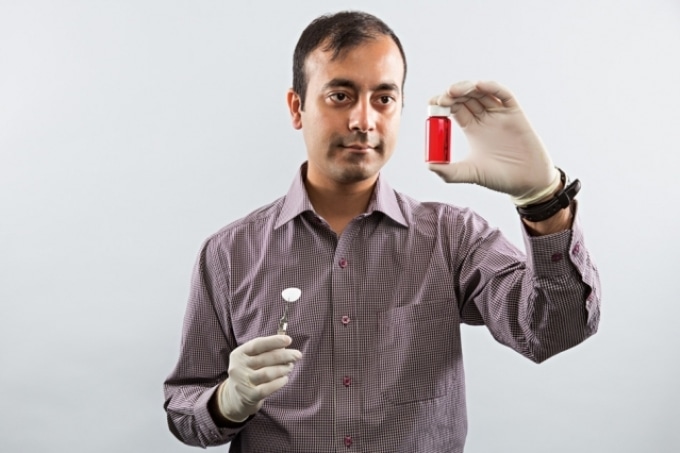Sep 1 2016
 (Photo: Ken Richardson)
(Photo: Ken Richardson)
Researchers working in Rohit Karnik’s lab are searching for tiny solutions to some of the biggest challenges the world is facing.
Karnik, an associate professor in MIT’s Department of Mechanical Engineering, is creating a new microfluidic technology that is capable of sorting cells from small blood samples quickly and easily. The microfluidic channel’s surface is patterned to direct specific cells to roll toward a reservoir for additional analysis, while allowing the remaining blood sample to pass through.
Using this design, Karnik hopes to build portable, disposable devices that doctors could use, even in remote areas of the world, to rapidly diagnose conditions of numerous diseases, such as malaria and sepsis.
Karnik’s team is also analyzing issues relating to water purification. The team are designing filters using single layers of graphene (atom-thin sheets of carbon), which are known for their outstanding strength.
Karnik has derived a method to manipulate the size and concentration of pores in graphene, and is customizing individual layers to filter out tiny and otherwise elusive contaminants. The team have also effectively filtered salts using the method and plan to create smart graphene filters for water purification and other applications.
While hunting for water-purifying solutions, Karnik’s team spotted an unexpectedly low-tech option: a simple branch of a tree. Karnik discovered that the pores found inside a pine branch, which usually help to transport water up the plant, are perfect for filtering bacteria from water.
The team has illustrated that a peeled pine branch is capable of filtering out up to 99.00% of E. coli from contaminated water. Karnik’s team is enhancing this research to investigate the potential for simple and economical wood-based water purification systems.
I try to guide my research by long-term sustainability, in a specific sense, by asking myself the question, ‘What can we do today that will have a lasting impact and be conducive to a sustainable human civilization? I try to align myself with that goal.
Rohit Karnik, Associate Professor, MIT
From Stargazer to Tinkerer
Born and raised in Pune, India, Karnik describes himself growing up as shy, yet curious about how things worked in the world. He would frequently conduct his own simple experiments in the backyard.
For instance, he discovered that transplanting ants from one colony to another changed the behavior of ants. He picked up an interest in astronomy and regularly explored the night sky using a small telescope.
I used to take my telescope up to the terrace in the middle of the night, which required three different trips up six or seven flights of stairs. I’d set the alarm for 3 a.m., go up, and do quite a bit of stargazing.
Rohit Karnik, Associate Professor, MIT
That telescope soon found new uses. Karnik discovered that by inverting it and adding another lens, he could repurpose the telescope as a microscope.
“I built a little setup so I could look at different things, and I used to collect stuff from around the house, like onion peels or fungus growing on trees, to look at their cells,” Karnik says.
Karnik’s uncle inspired him to decide on a path of study. His uncle, a mechanical engineer built custom machines “that did all kinds of things, from making concrete bricks, to winding up springs,” Karnik says. “What I saw in mechanical engineering was the ability to building something that integrates across different disciplines.”
Seeking Balance and Insight
When Karnik joined the Indian Institute of Technology Bombay he studied mechanical engineering rather than electrical engineering, which was the more popular choice among students at the time. For his thesis, he worked on new methods to model 3D cracks in materials such as steel beams.
After graduating, Karnik chose the rapidly growing field of nanotechnology.
Arun Majumdar, an IIT alum and professor at the University of California at Berkeley, was researching biosensing and energy conversion in nanoscale systems. Karnik moved to California in 2002 to join the professor’s lab as a graduate student.
For his graduate research, Karnik worked on developing a microfluidic platform to quickly blend the contents of and analyze reactions occurring within droplets. He next pursued a PhD thesis in which he studied how fluid, flowing via minuscule, nanometer-sized channels, can be controlled to sense and direct molecules and ions.
As his graduate study came to an end, Karnik applied for a faculty position at MIT, and was accepted. However, he was still pursuing his PhD thesis at Berkeley and had not more than four years of experience beyond his bachelor’s degree.
To assist him in smooth transition, MIT offered Karnik an interim postdoc position in the lab of Robert Langer, the David H. Koch Institute Professor and a member of the Koch Institute for Integrative Cancer Research.
“It was an insightful experience,” Karnik remembers. “For a mechanical engineer who’s never been outside mechanical engineering, I basically had little experience how to do things in biology. It opened up possibilities for working with the biomedical community.”
When Karnik finally took up his position as assistant professor of mechanical engineering in 2007, he had to deal with tons of responsibilities, deadlines, and demands — a universal initiation for first-time faculty.
By its nature the job is overwhelming. The trick is how to maintain balance and sanity and do the things you like, without being distracted by the busyness around you, in some sense.
Rohit Karnik, Associate Professor, MIT
He says many things have enabled him to endure and even tackle stress, such as walks, which he does regularly to work and around campus, accompanied by sessions of yoga and meditation.
“If you can see things the way they are, by clearing away the filters your mind puts in place, you can get a clear perspective, and there are a lot of insights that come through,” Karnik says.